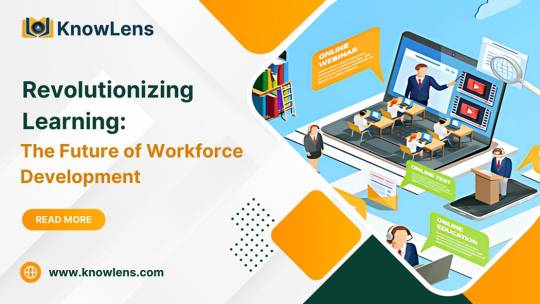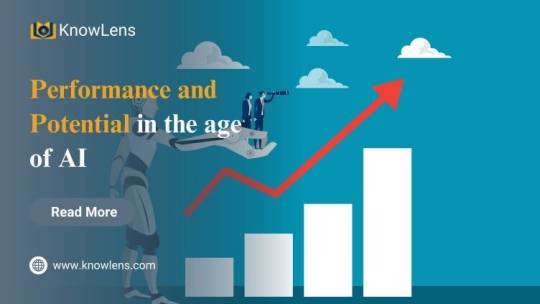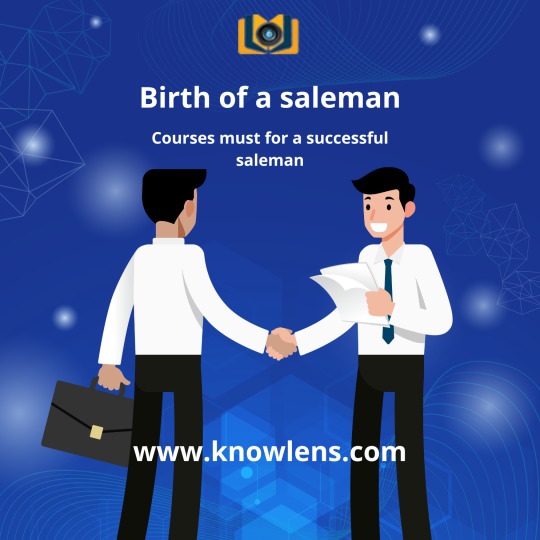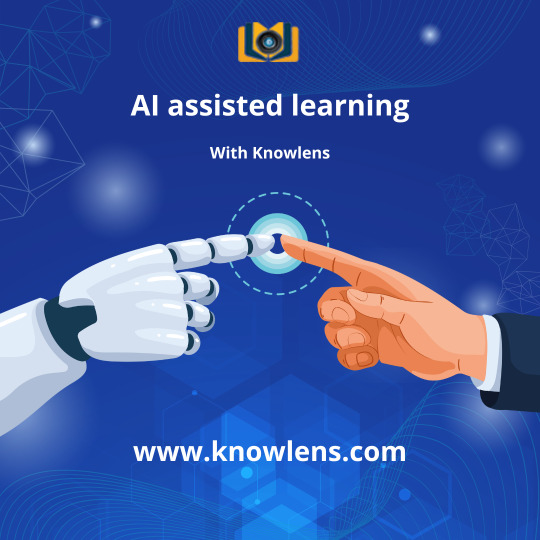Passionate about impactful visual learning, the Knowlens has been a pioneer in evangelising visual learning. Its offering straddles the gamut of visual forms in learning from web series to short videos to animation and interactive e- learning formats.
Don't wanna be here? Send us removal request.
Text
Content creation and management tool for corporate training
At the heart of the LMS, the Knowlens Course Builder stands out as a powerful content creation and management tool for corporate training needs. Designed with a modern visual interface, it enables quick, easy, and efficient course development. From SCORM packages to videos and document formats, it supports a wide range of content types to deliver impactful learning experiences.
#content tool#management tool#corporate training tools#corporatelearning#learning management software
0 notes
Text

From Office-Centric Roots to Human-Centric Realities: The Evolution of Learning and Development
The COVID-19 pandemic didn’t just disrupt workplaces, it disrupted decades of convention. Commercial buildings emptied, face-to-face interactions vanished and training rooms gathered dust. Learning and Development (L&D) professionals found themselves asking: How do we continue to build skills, foster growth, and engage learners—without the office? In this piece we look at whats been the permanent damage or rather the influence of Covid…of course we are talking the health of corporate learning…
0 notes
Text

Visual learning courses - Knowlens
Visual learning courses have transformed education by making content more engaging and easier to understand. With videos, simulations, and AI tools, these courses offer a powerful way to learn faster and retain more.
0 notes
Text
The Evolution of Visual Learning
Editor’s Note This edition explores how visual learning has transformed — from early symbolic art to today’s engaging digital experiences. We’re excited to share how The Win Win Game, our negotiation-based video case study, has been successfully tailored into a classroom training module by a top real estate company. Plus, get an insider’s view of how our testing infrastructure keeps our LMS and online courses running smoothly.

Lens Insight
The Journey of Visual Learning
Visual learning has been an integral part of human education for centuries — from ancient hieroglyphics to intricate diagrams of early scholars. Today, it includes everything from explainer videos to interactive infographics and whiteboard animations. These tools don’t just simplify complex topics; they also boost memory retention, making learning more effective.
How Visual Learning Has Evolved
The journey of visual learning reflects society’s evolving educational needs. Here’s how key innovations shaped the landscape:
The Chalkboard (1800s) — Marked the rise of collaborative learning in classrooms. It introduced a reusable surface that supported real-time interaction — laying the groundwork for modern educational tools.
Educational TV (1950s–60s) — Programs like Sesame Street brought lively, visual-based education into homes, engaging young minds and reshaping how we define classroom boundaries.
Personal Computers (1980s–90s) — Tools like PowerPoint and early multimedia applications transformed lectures into interactive experiences, giving educators new ways to bring content to life.
The Internet (1990s–2000s) — The web democratized access to learning resources. Films such as 12 Angry Men became popular in training environments, offering rich discussion points for leadership, persuasion, and group behavior.
Learning Management Systems (2000s) — Platforms such as Moodle and Blackboard centralized course delivery. With SCORM support, content could be reused and tracked across multiple platforms, making eLearning more structured and measurable.
Smartphones and Apps (2010s) — Educational content became mobile. YouTube emerged as a learning hub, and platforms like Udemy empowered instructors to create and distribute visually rich content, making learning more accessible and customizable.
Visual Learning’s Next Leap: AI Integration
As we move through the 2020s, artificial intelligence is redefining visual learning. AI-powered tools are introducing personalized content delivery, intelligent tutoring systems, and adaptive video experiences that respond to learners’ progress in real time.
At Knowlens, we see immense potential at the intersection of AI and visual learning. But for this potential to be realized, the content must not only be engaging but also purpose-driven — avoiding information overload and focusing on real-world application. This is where the synergy between skilled content creators and advanced technology becomes critical. Together, we can ensure the learning experience is not only memorable but also actionable.
Inside Knowlens
Customizing Video-Based Training for Real Estate
The Win Win Game — our negotiation-focused video case study — was recently adapted into an instructor-led training program for a major real estate firm.
Originally designed to illustrate negotiation principles such as active listening, rapport building, BATNA, and ZOPA through real-life scenarios, the course was revamped to align with the specific challenges faced by real estate professionals.
The revamped format included role-playing exercises and discussion-based learning. Participants viewed and dissected video clips in light of real estate stakeholder dynamics — whether dealing with clients, vendors, or government bodies. This approach helped bridge the gap between abstract strategy and day-to-day negotiation situations.
Feedback collected post-training revealed that team members felt more confident and better equipped to manage complex negotiations. They also gained practical insights into understanding stakeholder motivations — key for successful real estate transactions.
Knowbyte Research shows that 70% of learners prefer watching videos over reading text, thanks to the enhanced engagement and retention videos offer.
Upgrade Hub
How We Keep the LMS Reliable: AI-Powered Testing
This month, we’re spotlighting our behind-the-scenes efforts to maintain performance across our LMS and online learning platform. Our AI-driven, no-code testing engine automatically runs complex test scenarios — validating essential user paths without manual input. This system allows us to detect bugs early, reduce downtime, and deliver a seamless experience to our learners. It’s a quiet but powerful component ensuring the stability and scalability of Knowlens learning tools.
0 notes
Text
Revolutionizing Learning: The Future of Skills Development Opportunities
In today’s fast-paced, tech-driven world, companies must prioritize skills development opportunities to remain competitive and foster a thriving workforce. Learning and development (L&D) isn’t just an HR responsibility — it’s a critical business driver. A study by Bersin by Deloitte reveals that organizations with strong learning cultures enjoy 30–50% higher employee retention and a 46% better return on training investments.

Limitations of Traditional Learning Models
Despite the importance of continuous learning, traditional training methods often fall short. A recent survey shows that 74% of Millennial and Gen Z employees would consider quitting if they lack meaningful skills development opportunities and the freedom to guide their own learning. Conventional instructor-led training is typically rigid, one-size-fits-all, and costly. These barriers often prevent learners — especially those juggling work, personal commitments, or geographic constraints — from accessing impactful learning experiences.
This growing disconnect is prompting L&D professionals to seek out more innovative, flexible, and scalable ways to deliver skills development opportunities to employees.
The Future of Workforce Learning
Modern learning strategies emphasize autonomy and relevance. E-learning platforms are leading this evolution, offering on-demand access to personalized skills development opportunities. IBM reports that companies using digital learning tools see an 18% higher engagement rate and 26% more revenue per employee.
One cornerstone of this transformation is the Learning Management System (LMS) — a centralized, digital platform that enables course distribution, learner engagement, collaboration, and real-time progress tracking.
Key Features Driving Better Skills Development Opportunities
1. Personalized Learning Journeys Using real-time data and analytics, L&D teams can tailor learning paths to suit each individual’s needs, job role, and skill level. Personalized skills development opportunities ensure that employees learn what’s relevant to them — improving both engagement and knowledge retention.
2. Microlearning and Bite-Sized Content Short, targeted learning modules fit better into busy workdays and cater to modern attention spans. Daily micro-lessons focused on specific skills help employees steadily grow their knowledge without overwhelming them.
3. Gamification for Motivation Incorporating game elements — like points, badges, and leaderboards — adds an element of fun while boosting engagement. Employees are more likely to take ownership of their skills development opportunities when they can track their progress in an interactive way.
4. AI-Powered Assessments AI tools can evaluate learning outcomes, adapt course materials, automate feedback, and identify knowledge gaps — making skills development opportunities more personalized and responsive. However, human oversight remains essential to ensure fairness and transparency in automated evaluations.
5. AI Chatbots for Real-Time Support AI-driven chatbots enhance the learning experience by offering real-time guidance, answering queries, and helping learners stay on track. While they can’t replace human trainers, they significantly increase accessibility and responsiveness.
6. Multi-Channel Content Delivery Diversifying content formats — text, video, audio, interactive simulations — makes learning more inclusive and engaging. A multi-channel approach caters to different learning styles and makes skills development opportunities more effective and enjoyable.
Conclusion: Embracing the Future of Learning
As the workplace continues to evolve, so must the way companies deliver learning. Modern tools empower L&D professionals to offer highly personalized, flexible, and effective skills development opportunities. Tailored training for specific roles and departments not only maximizes relevance but also minimizes time wasted on unnecessary content.
By investing in smarter learning strategies, companies can boost employee satisfaction, increase retention, and improve overall performance. The future of workforce development is digital, dynamic, and driven by continuous skills growth — and now is the time to embrace it.
0 notes
Text

Learning Management System for Corporates
Transform Corporate Training with a Scalable Learning Management System – Boost Employee Performance with Knowlens LMS
#CorporateLMS#EmployeeTraining#DigitalLearning#OnlineTrainingPlatform#Knowlens#CorporateLearning#LMSforEnterprises
0 notes
Text

Sales training program
The Birth of a Salesman" is a film-based sales training program that follows the story of Abhay, a relationship manager. It realistically portrays everyday situations in a sales organization, highlighting various customer types, key stages of a sales call, and offering in-depth analysis of each stage based on expert research.
#ai learning#entrepreneur#book blog#ai based learning#books#literature#success#knowlens#sales training#sales hack
0 notes
Text

Training program on the fundamentals of communication skills.
About the Module:
Talk the Talk is a situation based training program on the fundamentals of communication skills. It utilizes a rich of mix of videos of different communication situations woven into an insightful and structured narrative covering different aspects of communication
0 notes
Text
Bridging the Gap Between L&D and the Learner: Rethinking How We Deliver Learning

Despite new tools and techniques — like adaptive learning and microlearning — completion rates for online programs remain underwhelming. And while some learners eagerly pursue development, a large majority still require external motivation or structured guidance.
So, where’s the missing link? Why do well-designed L&D programs sometimes fail to deliver real impact? While the answers aren’t always easy to implement, the core issues are surprisingly straightforward. Here are six critical gaps — and how we can begin to bridge them.
1. From Product Knowledge to Practical Application
Many organizations default to training employees on product or process knowledge. It’s a logical starting point, but often lacks real-world context. For example, compliance training typically lists dozens of do’s and don’ts. But do learners genuinely retain 50 bullet points? Probably not.
The shift needs to be toward application-oriented learning — embedding realistic scenarios, challenges, and decision-making into training. A sales training program, for instance, shouldn’t just explain product features but should link them to persuasive selling strategies with concrete, relatable examples.
2. Business-Led Learning, Not Just L&D Initiatives
True learning impact stems from aligning L&D with business goals. That means L&D professionals must immerse themselves in the field, understand operations, and observe actual business problems.
Whether it’s sales, customer service, or backend operations, effective training must reflect the day-to-day realities of learners. When programs are co-created with business teams, they become more grounded, relevant, and ultimately, more successful.
3. Personalization Over One-Size-Fits-All
One of L&D’s biggest hurdles is scaling personalized learning. While digital tools and AI-based platforms make this more feasible today, we still need to differentiate universal content from personal content.
For example, a foundational product journey can be standardized and delivered at scale, while targeted microlearning (like handling specific customer objections) should be designed for individual learners facing those exact challenges. The future of learning lies in balancing scale with specificity.
4. Turning Principles Into Real-Life Experiences
Theoretical content without practical relevance is quickly forgotten. If we want to teach competency-based behavior, simply listing attributes in a slide deck won’t cut it.
What resonates more? Realistic portrayals. Imagine training that showcases how core behaviors play out for a bank cashier, a call center agent, or a sales manager. Learners engage more when they see themselves in the content and understand how to act on the principles.
5. Evolving Content Formats to Break Boredom
Another frequent complaint? E-learning is boring. That’s often because the format isn’t tailored to the content.
Yes, SCORM modules have their place — but pairing them with interactive videos, simulations, or storytelling can transform engagement. In one case, a client wanted micro-content under four minutes. But when we delivered seven-minute videos filled with narrative and relevance, the feedback was: “I didn’t even notice the time.”
The takeaway? It’s not just about duration — it’s about emotional engagement and contextual storytelling.
6. Cultivating Curiosity and a Spirit of Experimentation
L&D often falls into familiar patterns — trusted vendors, repeated delivery formats, known investment strategies. But in a world of rapid change, playing it safe may no longer be safe.
Being curious, taking calculated risks, and exploring new formats or methodologies is essential. Whether it’s immersive video, gamification, AI tutors, or reverse mentoring, bold experimentation is how L&D can stay ahead and stay relevant.
And who better to drive this innovation than L&D professionals themselves?
Final Thoughts
The future of learning is not just digital — it’s deeply human, contextual, and immersive. At Knowlens, we think about these challenges every day as we design learning experiences that truly connect with people.
If L&D professionals start with curiosity, focus on real-world applications, and commit to learner-centric design, they won’t just bridge the gap — they’ll build a thriving learning culture.
0 notes
Text

A film based course on Code of Conduct & Ethics.
"The Right Way" is a film based course on Code of Conduct & Ethics. This course comprises ten cases which showcase various scenarios, one encounters in our corporate or business life. These vary from conflict of interest to dealing with internal stakeholders and business partners. The roleplay showcased in these situations, also give you a template to handle any hitherto unseen situation.
0 notes
Text

POSH training for workplace security of women
Step Up is a film based training program which covers the key concepts related to POSH starting from its history, legal aspects and finally practical aspects of POSH from a everyday perspective. Told in the form of a film with multiple stories woven together using a web series approach, it provides a compelling and informative look at different aspects -What is Sexual Harassment along with key concepts as per the Act, Organization & stakeholder responsibility, Grievance Redressal and finally the impact of POSH on individuals and the corporate.
0 notes
Text
Performance and Potential in the Age of AI
Effective talent management is critical for organizations aiming to nurture internal talent and fuel long-term growth. A central pillar of this process is identifying high-potential employees and enabling their career advancement — even when the future roles demand skills that differ significantly from their current expertise.

AI & Unlocking Potential
AI thrives on vast and complex data. It can analyze performance trends, learning patterns, and Talent-Needs-Inventory (TNI) outputs across roles, offering valuable insights into an employee’s future trajectory.
By mapping competencies across different functions and understanding the dynamic networks of organizational hierarchies, AI becomes an essential tool in succession planning. It helps leaders identify individuals who may be ready to take on new challenges — even if their current roles don’t obviously suggest it.
From a Learning & Development (L&D) perspective, AI opens the door to adaptive learning experiences. Tailored training paths can be created for each employee, maximizing development based on both current performance and future potential.
AI & Performance Management
AI’s role in automating routine tasks and driving efficiency is well known. But its deeper value lies in how it can evaluate and even enhance performance in real time — especially when supported by a strong data culture within the organization.
For example, AI-powered performance reviews can offer objective insights by analyzing a wide range of behavioral and performance metrics. Predictive analytics can also spotlight future performance trends and skill gaps, giving managers a proactive edge in workforce planning.
Conclusion: Master or Slave?
While the benefits of AI in talent management are immense, it comes with an important caveat. AI must remain a tool — a powerful one, but still a tool. The risk lies in over-reliance, where decision-making becomes overly dependent on algorithms rather than human judgment.
Human resources, by definition, are about people. If organizations forget that, the master (humans) could end up serving the slave (AI). Like all transformative technologies, AI has the potential to be either a boon or a bane. The key lies in how we choose to use it.
0 notes
Text

Courses for management in corporate
'Three Aces and a Manager’ is a film based module on key Managerial Skills. It is a story of Harsh, a young manager who goes through the evolutionary journey from being an individual performer to managing a team. The film shows the challenges of dealing with different kinds of individuals– arrogant high performers, youngsters, experienced old hands, demanding seniors and competitive peers. It covers diverse skills from bonding with the team to building trust, to handling conflict, to driving team performance through reviews, feedback and capability building. Each of these skills is analysed in detail by experts.
0 notes
Text

Birth of a saleman
Must Courses for a successful saleman
visit us: https://www.knowlens.com/
0 notes
Text

AI assisted learning with Knowlens
visit us: https://www.knowlens.com/
1 note
·
View note